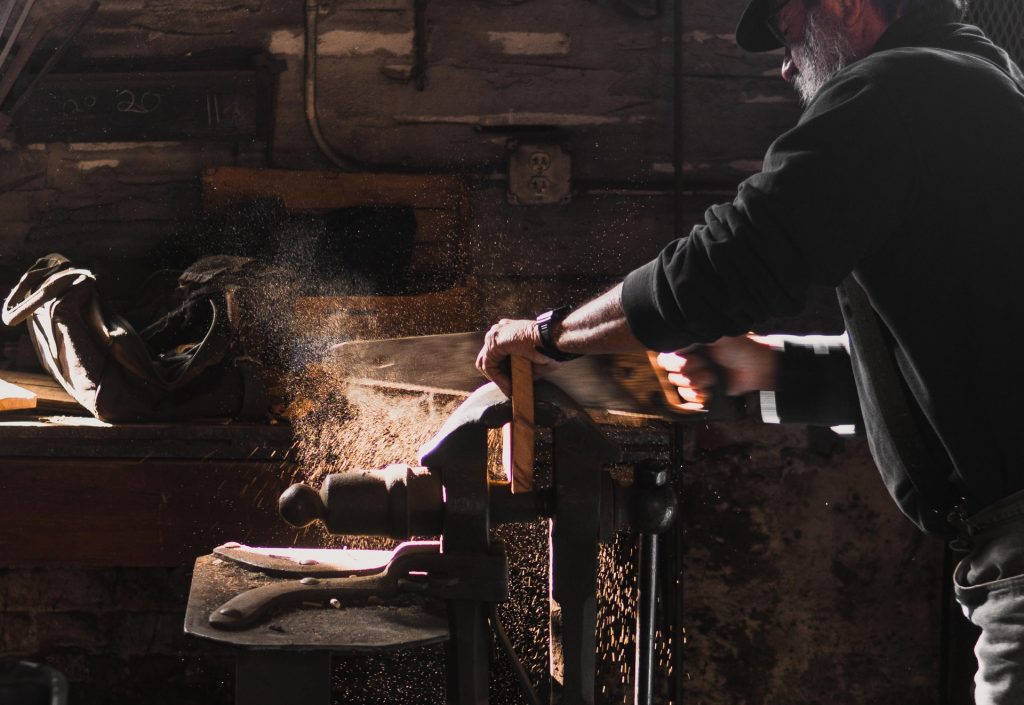Miter saws are a versatile tool that is a must-have in any carpenter’s kit. They are perfect for projects such as cutting molds and their installation.
You can also cut chair rails with this tool. However, you need to adjust your saw accordingly and have to be careful of some factors.
To help you, we have prepared this guide.
Quick Summary
By the end of this article, we will go through:
- How you can cut chair rails with your miter saw.
- What are the different types of miter saws?
Let’s take a look at it.
How to Cut Chair Rails With a Miter Saw?
Chair rails are moldings that go around the room at the height of 90 inches or more. They were originally intended to protect the walls of a room against the backs of chairs. These days, they are an aesthetic feature on the wall.
In order to craft a chair rail molding, you have to make careful cuts. You want to avoid uneven bars and edges. Miter saws are an excellent tool you can use in order to cut a chair rail. You can make cuts at different angles with a miter saw.
Miter saws are perfect for 45-degree angle cuts, especially for inside corners. You need to make cuts that are seamless so that the molds fit in.
When you cut chair rails, you need to:
Step # 1 – Make sure you have the right tools
Before you begin your work, you need to make sure that you have all the necessary equipment. This will help you maintain a professional look on your home improvement project.
You will need:
- Nails
- Molding pieces
- Sandpaper
- Hammer
- Angle measuring tool
- Bubble level
- Miter saw with box
All these tools will help you perfectly cut and install a chair rail in your home.
Step # 2 – Choose where you want to install the chair rail
After you have ensured that you have all the right tools, you need to locate the site where you want the chair rail. It depends on your tastes, but a chair rail normally goes 30 to 36 inches above the floor. This is about 3 feet above the floor.
You also need to remember that you must first measure the ceiling height. This gives you an idea of how much width the molding should have. For example, if your ceiling is 10 feet tall, then the width of your molding will be about 7”.
In the case of shorter ceilings, 4” wide moldings are enough.
You can measure the distance with an inch tape. Then you need to mark the height with a pencil.
You also need to consider what style of chair rail you want. There are many different kinds of styles you can choose from. But be sure that it matches the aesthetics of your room.
Step # 3 – Mark the walls and the wall studs
After you have marked the height at which you want to attach the chair rail molding, you need to mark the walls. You need to mark the length from one corner of the wall to another. Be sure that you do this with a pencil.
Also, you need to be sure that it is level. You can check it with a bubble level. You also need to measure the length needed for the molding.
Then, you can search for the wall studs. The studs support your chair rail. You also cannot nail the chair rail directly onto drywall. Hence, it is a must that you locate and mark the stud before installing the chair rail mold.
You can use an electronic stud finder to locate the studs.
Step # 4 – Cut the molding for the chair rail
After you have made the necessary adjustments and the measurements, you can cut the piece. Use your miter saw for this purpose.
Be sure that you set a 90-degree angle for all the inside corners. For outside corners, you need to keep it at a 45-degree angle.
For a cleaner seam, we recommend that you use a coping saw. A coping saw works better than a mitering one in the case of inside angles. For this, the first piece of the wood should be cut square to the saw. It will set the angle at 90 degrees.
In order to fit in with the ends, the other piece is cut at a slight angle. Mark the piece where you will be coping the wood, then you need to make the cut. You can do this with a coping saw.
For safety as well as a cleaner cut, we recommend that you clamp down your molding. It will ensure that the blade does not deviate.
To ensure that the two pieces have been cut perfectly, you must line them up. The opposite ends should line up together. This means that it should be a tight fit between the two corners.
You can use this technique for all the inside joints.
Step # 5 – Attach the chair rails
After you have cut all the pieces of the chair rail, you need to attach them to the wall. First, attach the inside corner to the wall and then move on to the other pieces.
To attach the chair rails, first, attach them with glue. Then, you can nail them to the wall studs. Remember that drywall can crumble if you try to nail the wood directly when installing it.
Repeat this process for all the pieces.
Step # 6 – Sand the chair rail
Next, you need to sand the molding. You want to eliminate any gap between the chair rail and the wall so that the molding is flush with your wall.
Lightly sand down the piece with sandpaper. You can also do this before installing the pieces to the wall.
Also, you need to prepare the pieces for painting over them in this step with the sandpaper.
Step # 7 – Fill in Nail holes
Then, you have to fill in the nail holes. There may be multiple gaps that you have to top up with some filler. You can use colored putty for this. Be sure that you clean it with some thinner afterward.
This ensures that the paint applied to the chair rail is seamless.
Step # 8 – Apply the paint
Lastly, you need to apply the paint to the pieces. We recommend that you first test the paint on a small piece of the workpiece before you apply it to the walls.
Be sure that the paint color matches the overall aesthetic and vibe of the room.
Learn more with our various RESOURCE GUIDES
What Are the Different Types of Miter Saws?

There are different kinds of miter saws that are available in the market. They each have their own specialties and can be used for different settings.
Each type of miter saw varies and can be used for cutting different materials. Let’s take a look at each on
Sliding Miter Saw
This kind of miter saw is perfect if you want to add rails to your workpiece. The saw allows the blade to slide back and forth for cutting rails easily. The saw gives cuts of greater depth and is perfect for cutting 1×12 or 2×12 lumber.
Compound Miter Saw
A compound saw has the ability to do both miter and bevel cuts. These saws are perfect for cutting crown moldings or other types of trim to install on the wall.
These saws are good if you want to regularly cut a piece of lumbar.
Dual Compound Sliding Miter saw
This saw has a table, as well as sliding rails. You can bevel the saw blade in both directions with this tool. This feature enables the user to cut the piece of lumbar in opposite directions without flipping it.
A dual compound saw can function in different ways, but its cost is high.
Wrapping Things Up…
We agree that cutting chair rail moldings for the wall can be a tough job without the necessary tools. However, by following our guide thoroughly, you can perform the cuts with ease.
With this, we reach the end of our article on “How to cut chair rail corners with a miter saw?”.
Do let us know what you think in the comments. Visit our website.

